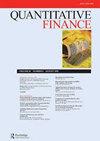分布式健壮的端到端投资组合构造
IF 1.4
4区 经济学
Q3 BUSINESS, FINANCE
引用次数: 3
摘要
摘要提出了一种端到端的分布鲁棒组合构建系统,该系统将资产收益预测模型与分布鲁棒组合优化模型相结合。我们还展示了如何直接从数据中学习风险容忍参数和鲁棒性程度。端到端系统的优势在于,在训练过程中,信息可以在预测层和决策层之间进行交流,允许为最终任务训练参数,而不仅仅是为了预测性能。然而,现有的端到端系统无法量化和纠正模型风险对决策层的影响。我们提出的分布式健壮的端到端投资组合选择系统明确地考虑了模型风险的影响。决策层通过解决一个极大极小问题来选择投资组合,在这个问题中,资产收益的分布被假设属于一个以名义分布为中心的模糊集。利用凸对偶性,我们将极大极小问题转化为一种允许对端到端系统进行有效训练的形式。关键词:投资组合优化资产配置机器学习分布鲁棒性优化统计歧义披露声明作者未报告潜在利益冲突数据可用性支持本研究数值实验的数据可从以下两个来源在线获得。特征数据:这些数据可以通过Kenneth French的数据库(https://mba.tuck.dartmouth.edu/pages/faculty/ken.french/data_library.html.Asset data: AlphaVantage at www.alphavantage.co)获得。这些数据的可用性受到限制,这些数据在本研究的免费学术许可下使用。这篇文章经过了细微的修改。这些变化不影响文章的学术内容。注1关于ϕ-散度函数及其凸共轭的描述,请参见Ben-Tal et al. (Citation2013)中的表2和表4如果φ是海灵格距离,则假设命题2.1中的函数R(X)是二次的或分段线性的,则DR层简化为二阶锥规划。如果ϕ是变分距离,则提供函数R(X)是分段线性的,则DR层减少为线性程序。否则,问题的复杂性取决于R(X)的选择请注意,我们使用投资组合收益而不是投资组合超额收益(即超过无风险利率的收益)来定义夏普比率。本研究得到了加拿大自然科学与工程研究委员会的支持[PDF - 557467 - 2021]。本文章由计算机程序翻译,如有差异,请以英文原文为准。
Distributionally robust end-to-end portfolio construction
AbstractWe propose an end-to-end distributionally robust system for portfolio construction that integrates the asset return prediction model with a distributionally robust portfolio optimization model. We also show how to learn the risk-tolerance parameter and the degree of robustness directly from data. End-to-end systems have an advantage in that information can be communicated between the prediction and decision layers during training, allowing the parameters to be trained for the final task rather than solely for predictive performance. However, existing end-to-end systems are not able to quantify and correct for the impact of model risk on the decision layer. Our proposed distributionally robust end-to-end portfolio selection system explicitly accounts for the impact of model risk. The decision layer chooses portfolios by solving a minimax problem where the distribution of the asset returns is assumed to belong to an ambiguity set centered around a nominal distribution. Using convex duality, we recast the minimax problem in a form that allows for efficient training of the end-to-end system.Keywords: Portfolio optimizationAsset allocationMachine learningDistributionally robust optimizationStatistical ambiguity Disclosure statementNo potential conflict of interest was reported by the author(s).Data availabilityThe data that support the numerical experiments in this study are available online from the following two sources below. Feature data: These data are openly available through Kenneth French's Data Library at https://mba.tuck.dartmouth.edu/pages/faculty/ken.french/data_library.html.Asset data: AlphaVantage at www.alphavantage.co. Restrictions apply to the availability of these data, which were used under a free academic license for this study.Correction StatementThis article has been corrected with minor changes. These changes do not impact the academic content of the article.Notes1 For a description of ϕ-divergence functions and their convex conjugates, please refer to Tables 2 and 4 in Ben-Tal et al. (Citation2013).2 If ϕ is the Hellinger distance, the DR layer reduces to a second-order cone program provided the function R(X) in Proposition 2.1 is quadratic or piecewise linear. If ϕ is the Variational distance, the DR layer reduces to a linear program provided the function R(X) is piecewise linear. Otherwise, the complexity of the problem is dictated by the choice of R(X).3 Note that we have defined the Sharpe ratio using the portfolio returns rather than the portfolio excess returns (i.e. the returns in excess of the risk-free rate).Additional informationFundingThis work was supported by Natural Sciences and Engineering Research Council of Canada [PDF - 557467 - 2021].
求助全文
通过发布文献求助,成功后即可免费获取论文全文。
去求助
来源期刊

Quantitative Finance
社会科学-数学跨学科应用
CiteScore
3.20
自引率
7.70%
发文量
102
审稿时长
4-8 weeks
期刊介绍:
The frontiers of finance are shifting rapidly, driven in part by the increasing use of quantitative methods in the field. Quantitative Finance welcomes original research articles that reflect the dynamism of this area. The journal provides an interdisciplinary forum for presenting both theoretical and empirical approaches and offers rapid publication of original new work with high standards of quality. The readership is broad, embracing researchers and practitioners across a range of specialisms and within a variety of organizations. All articles should aim to be of interest to this broad readership.
 求助内容:
求助内容: 应助结果提醒方式:
应助结果提醒方式:


